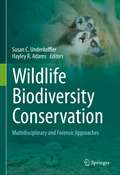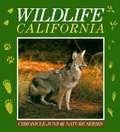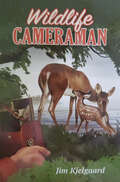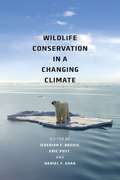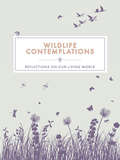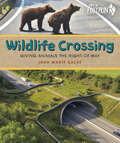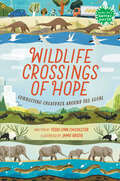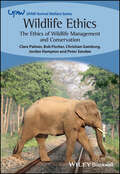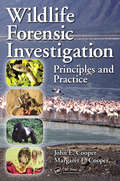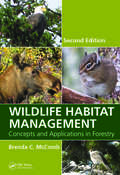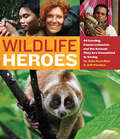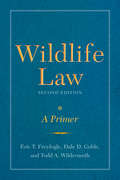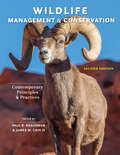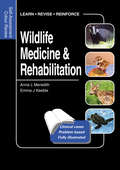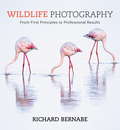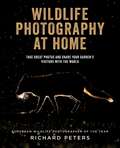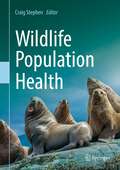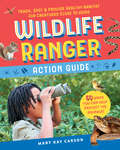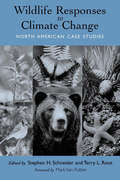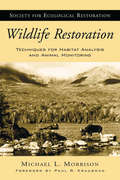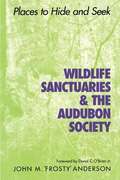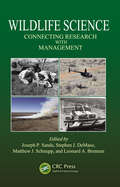- Table View
- List View
Wildlife Biodiversity Conservation: Multidisciplinary and Forensic Approaches
by Susan C. Underkoffler Hayley R. AdamsThis book addresses the multidisciplinary challenges in biodiversity conservation with a focus on wildlife crime and how forensic tools can be applied to protect species and preserve ecosystems. Illustrated by numerous case studies covering different geographical regions and species the book introduces to the fundamentals of biodiversity conflicts, outlines the unique challenges of wildlife crime scenes and reviews latest techniques in environmental forensics, such as DNA metagenomics. In addition, the volume explores the socio-economic perspective of biodiversity protection and provides an overview of national and international conservation laws. The field of conservation medicine stresses the importance of recognizing that human health, animal health, and ecosystem health are inextricably interdependent and the book serves as important contribution towards achieving the UN Sustainable Developmental Goals, in particular SDG 15, Life on Land. The book addresses graduate students, scientists and veterinary professionals working in wildlife research and conservation biology.
Wildlife California
by Jill BrubakerThe book is a nature guide focusing on the mammals, reptiles, and birds that are found in the wilderness areas of California.
Wildlife Cameraman
by Jim KjelgaardYoung Jase Mason’s ambition was to be a wildlife photographer. To find out whether or not he had real ability, he spent a summer in the wilderness with his dog and his cameras. It was a summer filled with adventure. Living close to nature, boy and dog both learned a great deal about wilderness dwellers, from rabbits to bears and moose. They also became unexpectedly involved with game wardens and poachers. Through it all, Jase stubbornly stuck to his ambition to become a wildlife cameraman. Author of a score of fine books about the outdoors, Jim Kjelgaard here combines his mastery of open-air adventure with a story of youthful determination and hard work in the face of obstacles. He also shows how nature maintains its own balance among living things, and how man can maintain or upset that balance by his attitude toward conservation
Wildlife Conservation in a Changing Climate
by Jedediah F. Brodie, Eric Post, and Daniel F. DoakHuman-induced climate change is emerging as one of the gravest threats to biodiversity in history, and while a vast amount of literature on the ecological impact of climate change exists, very little has been dedicated to the management of wildlife populations and communities in the wake of unprecedented habitat changes. Wildlife Conservation in a Changing Climate is an essential resource, bringing together leaders in the fields of climate change ecology, wildlife population dynamics, and environmental policy to examine the impacts of climate change on populations of terrestrial vertebrates. Chapters assess the details of climate change ecology, including demographic implications for individual populations, evolutionary responses, impacts on movement patterns, alterations of species interactions, and predicting impacts across regions. The contributors also present a number of strategies by which conservationists and wildlife managers can counter or mitigate the impacts of climate change as well as increase the resilience of wildlife populations to such changes. A seminal contribution to the fields of ecology and conservation biology, Wildlife Conservation in a Changing Climate will serve as the spark that ignites a new direction of discussions about and action on the ecology and conservation of wildlife in a changing climate.
Wildlife Contemplations: Reflections on Our Living World
by Various‘All paths lead nowhere, so it is important to choose a path that has heart.' - Carlos Castaneda. This beautifully packaged book offers the reader a rare opportunity to slow down and receive the natural restorative power of nature through a selection of beautiful, evocative quotes which transports the reader to a space of contemplative reflection inspired by wildlife.‘Once trodden by human feet, a natural path becomes a work of man, each traveller marking the way for the next, sometimes departing from the most direct or obvious route to avoid a muddy patch, or to keep out of sight of possible enemies. Feet follow foosteps and so a road is trodden in history.’ The Oldest Road, An Exploration of the Ridgeway, JRL Anderson and Fay Godwin
Wildlife Crossing: Giving Animals the Right-of-Way (Orca Footprints #32)
by Joan Marie GalatWhat happens when the needs of people and nature collide? More than 13 million miles of roads crisscross landscapes in 222 countries. Roads offer many human benefits, but they also create problems for nature. Their construction leads to a loss of biodiversity through habitat loss, fragmentation and degradation. Roads isolate wildlife populations, impede migration and allow invasive plant and animal species to spread, while giving rise to pollution from garbage, light, noise and airborne contaminants. With innovative tools, like wildlife overpasses to reconnect landscapes, smart roads and vehicles to maximize safety, and a little hands on help, we can create environmental harmony. And sitting in the passenger seat, young people can play a part in helping highways and habitats coexist. The epub edition of this title is fully accessible.
Wildlife Crossings of Hope: Connecting Creatures Around the Globe (Books for a Better Earth)
by Teddi Lynn ChichesterWe all need safe places to live and safe paths to travel. Animals, too.Meet the people who are stitching the planet's habitats back together.Let&’s explore together how scientists, engineers, and lots of everyday people are working to make sure that the wildlife so essential to Earth&’s health and beauty continues to freely move through the landscapes, waterways, and skylines of this richly inhabited planet. Combining first-person reporting with research and stunning two-color art from illustrator Jamie Green, Wildlife Crossings of Hope takes a personal, in-depth look at wildlife crossings, corridor projects, and dam removal efforts around the world, from an underpass for elephants in Kenya to the Un-Dam the Klamath movement in the U.S. to the Mesoamerican Biological Corridor, which extends from southern Mexico to Panama. Above all, this is a book that invites young people to think of themselves and wildlife as part of one community that urgently needs restoration and protection. Back matter includes actions for kids to take, a complete listing of the scientific names of all creatures discussed, source notes, a bibliography, an index, and more. Books for a Better Earth™ are designed to inspire children to become active, knowledgeable participants in caring for the planet they live on.A Junior Library Guild Gold Standard Selection
Wildlife Ethics: The Ethics of Wildlife Management and Conservation (UFAW Animal Welfare)
by Clare Palmer Bob Fischer Christian Gamborg Jordan Hampton Peter SandoeWildlife Ethics A systematic account of the ethical issues related to wildlife management and conservation Wildlife Ethics is the first systematic, book-length discussion of the ethics of wildlife conservation and management, and examines the key ethical questions and controversies. Tackling both theory and practice, the text is divided into two parts. The first describes key concepts, ethical theories, and management models relating to wildlife; the second puts these concepts, theories, and models to work, illustrating their significance through detailed case studies on controversies in wildlife management and conservation. The book explores pressing topics including human responsibilities due to climate change, tradeoffs when managing zoonotic disease risks, the ethics of the wildlife trade, culling non-native species, indigenous wildlife use, and zoo-based conservation programs. Readers are encouraged to explore different ways of valuing wild animals and their practical implications. This essential text: Explains and explores relationships between valuing biodiversity, human utility, ecosystems, species, and animal welfare Describes established approaches to wildlife management, such as sustainable use, and emerging concepts, such as compassionate conservation Discusses key ethical theories, including utilitarianism, ecocentrism, and animal rights Offers a practical model of how to analyze ethical issues in wildlife management and conservation Wildlife Ethics: The Ethics of Wildlife Management and Conservation is an accessible introduction to complex ethical issues, making the book an important resource for students in fields such as conservation biology, ecology, environmental science and policy, game management, public health and veterinary medicine. It will also be an invaluable tool for wildlife managers, conservationists, One Health practitioners, practicing veterinarians and animal rehabilitation staff, contemporary wildlife professionals and other stakeholders.
Wildlife Forensic Investigation: Principles and Practice
by John E. Cooper Margaret E. CooperProviding an in-depth introduction to the rapidly evolving field of wildlife forensics, this volume also chronicles aspects of the history of management, conservation, and environmental protection, with an emphasis on their global importance in the twenty-first century. The book examines the crucial role of wildlife forensic investigation with regard to live animals, dead animals, and samples and covers national, regional, and international legislation. The book discusses animal welfare as well as the damage that can be inflicted on humans and property by wildlife. The text is enhanced by case studies from experts who describe some of their own work.
Wildlife Habitat Management: Concepts and Applications in Forestry, Second Edition
by Brenda C. McCombShortlisted for the 2018 TWS Wildlife Publication Awards in the authored book categoryIn recent years, conflicts between ecological conservation and economic growth forced a reassessment of the motivations and goals of wildlife and forestry management. Focus shifted from game and commodity management to biodiversity conservation and ecological fore
Wildlife Heroes: 40 Leading Conservationists and the Animals They Are Committed to Saving
by Julie Scardina Jeff FlockenWith one-third of known species being threatened with extinction, wildlife conservationists are some of the most important heroes on the planet, and Wildlife Heroes profiles the work of 40 of the leading conservationists and the animals and causes they are committed to saving, such as Belinda Low (zebras), Iain Douglas-Hamilton (elephants), Karen Eckert (sea turtles), S.T. Wong (sun bear), Steve Galster (wildlife trade), and Wangari Maathai (habitat loss). Since we all should have an interest in conservation, there is a chapter providing information on ways people can get involved and make a difference. Chapter introductions are by author Kuki Gallmann, actor Ted Danson, actress Stefanie Powers, Congressman Jay Inslee, and TV personality Jack Hanna.
Wildlife Law, Second Edition: A Primer
by Eric T. Freyfogle Dale D. Goble Dr Todd A. WildermuthWildlife is an important and cherished element of our natural heritage in the United States. But state and federal laws governing the ways we interact with wildlife can be complex to interpret and apply. Ten years ago, Wildlife Law: A Primer was the first book to lucidly explain wildlife law for readers with little or no legal training who needed to understand its intricacies. Today, navigating this legal terrain is trickier than ever as habitat for wildlife shrinks, technology gives us new ways to seek out wildlife, and unwanted human-wildlife interactions occur more frequently, sometimes with alarming and tragic outcomes.This revised and expanded second edition retains key sections from the first edition, describing basic legal concepts while offering important updates that address recent legal topics. New chapters cover timely issues such as private wildlife reserves and game ranches, and the increased prominence of nuisance species as well as an expanded discussion of the Endangered Species Act, now more than 40 years old. Chapter sidebars showcase pertinent legal cases illustrating real-world application of the legal concepts covered in the main text.Accessibly written, this is an essential, groundbreaking reference for professors and students in natural resource and wildlife programs, land owners, and wildlife professionals.
Wildlife Management and Conservation: Contemporary Principles and Practices
by Paul R. Krausman And James W. Cain IIIThe definitive textbook for students of wildlife management, now updated to cover the latest techniques, tools, and topics.Wildlife Management and Conservation presents a clear overview of the management and conservation of animals, their habitats, and how people influence both. The relationship among these three components of wildlife management is explained in chapters written by leading experts and is designed to prepare students for careers in which they will be charged with maintaining healthy animal populations. To be successful wildlife professionals, they will need to find ways to restore depleted populations, reduce overabundant, introduced, or pest species, and manage relationships among various human stakeholders. This book gives them the basic knowledge necessary to accomplish these goals.This second edition, which is updated throughout, features several new and expanded topics, including communication in the wildlife profession, fire science, Indigenous models of management and conservation, plant–animal interactions, quantitative analysis of wildlife populations, and a detailed glossary. The book also covers:• Human dimensions of wildlife management• Animal behavior• Predator–prey relationships• Structured decision making• Issues of scale in wildlife management• Wildlife health• Historical context of wildlife management and conservation• Hunting and trapping• Nongame species• Nutrition ecology• Water management• Climate change• Conservation planningThe most widely used foundational text in the field, this is the perfect resource not only for students but also for early career professionals and those in related fields who need to understand the core tenets and tools of wildlife conservation and management.Contributors: C. Jane Anderson, Bart M. Ballard, Warren B. Ballard, John A. Bissonette, Clint Boal, Scott B. Boyle, Leonard A. Brennan, Robert D. Brown, James W. Cain III, Tyler A. Campbell, Michael J. Cherry, Michael R. Conover, Daniel J. Decker, Randall W. DeYoung, Jonathan B. Dinkins, W. Sue Fairbanks, Selma N. Glasscock, James B. Grand, Michael J. Haney, James R. Heffelfinger, Scott E. Henke, Fidel Hernandez, Davie G. Hewitt, C. L. Hoving, David A. Jessup, Heather E. Johnson, Winifred B. Kessler, John L. Koprowski, Paul R. Krausman, William P. Kuvlesky, Jr., Roel R. Lopez, R. W. Mannan, Scott Mills, Michael S. Mitchell, Michael L. Morrison, Anna M. Muñoz, John F. Organ, Katherine L. Parker, William F. Porter, Shawn J. Riley, Steven S. Rosenstock, Michael C. Runge, Susan P. Rupp, William F. Siemer, Robert J. Steidl, Kelley M. Stewart
Wildlife Medicine and Rehabilitation: Self-Assessment Color Review
by Anna Meredith Emma KeebleVeterinarians increasingly encounter wildlife casualties in practice and have a duty of care for the welfare of the animals. This comprehensive and easy-to-use self assessment book contains some 208 clinical cases with 325 illustrations. It has been compiled by authors with a wide range of experience and expertise in this area. Common conditions se
Wildlife Photography
by Richard BernabeThere is nothing quite so satisfying as capturing a stunning wildlife photograph; a good one will reflect practice, patience, careful equipment choice and dedication. Those challenges are perhaps why so many enthusiast photographers aspire to perfect their images in this area; to get their work recognised by the photographic community as well as record their experiences.This book reveals more world-class images with every turn. More than that, though, it takes a practical approach. It comprehensively introduces natural-history and wildlife photography techniques alongside truly useful tips about what gear you'll need (and what you can avoid) in your pursuit of perfection. It is illustrated by the author's professional work; his clients include National Geographic & Time amongst others.
Wildlife Photography at Home
by Richard PetersRichard Peters won the European Wildlife Photographer of the Year award for a photograph taken in his very ordinary suburban back garden. In this book, he shares the methods he used to get stunning professional nature photos without having to head out on safari.Starting with the basics, this book will show a complete beginner how to capture pro-level pictures from their garden. It covers where to place your camera, how optics can completely change your shot, reveals the gadgets that can enhance your photos, and even how to overcome the elements. This is the perfect book for bird-watchers and animal lovers who want to capture what they see and share their passion with the world. Social media definitely loves a good animal photo!
Wildlife Photography at Home
by Richard PetersRichard Peters won the European Wildlife Photographer of the Year award for a photograph taken in his very ordinary suburban back garden. In this book, he shares the methods he used to get stunning professional nature photos without having to head out on safari.Starting with the basics, this book will show a complete beginner how to capture pro-level pictures from their garden. It covers where to place your camera, how optics can completely change your shot, reveals the gadgets that can enhance your photos, and even how to overcome the elements. This is the perfect book for bird-watchers and animal lovers who want to capture what they see and share their passion with the world. Social media definitely loves a good animal photo!
Wildlife Politics
by Bruce RocheleauAttitudes towards charismatic animals such as tigers, lions, bears and wolves vary greatly and change over time, resulting in bitter political debates. This comprehensive book identifies and analyses the factors that influence policies across the globe, highlighting how this impacts conservation as a whole. Issues such as overexploitation, hunting, ecotourism and the struggle to prevent illegal wildlife trafficking are examined and science's role in policymaking is assessed. The conflicting forces behind legislation, including institutions, interest groups and the media are analysed, with particular focus on the significance of the Endangered Species Act, covering over forty-five species that have become matters of political debate in sixty-seven different countries. Case studies and conceptual frameworks provide a clear understanding of the key topics, shedding light on this important yet often overlooked area of environmental politics.
Wildlife Population Health
by Craig StephenThis textbook introduces the core competencies, tools and perspectives to manage free-ranging animal population health and demonstrates their need and relevance to help wildlife cope with the ever-increasing pressures of the Anthropocene, manifested by global megatrends such as climate change, urbanization and pollution. It adapts and adopts key concepts of population health from public health and herd health to a wildlife health context. In a highly-accessible and unique form, this book presents a modern way of approaching wildlife and fish epidemiology, health promotion and disease control, with a focus on the social dimensions of wildlife health management. Aimed at graduate students in veterinary medicine, wildlife researchers and health managers this textbook provides a valuable source of information to foster the knowledge and skills needed to protect and promote the health of free-ranging wildlife.
Wildlife Ranger Action Guide: Track, Spot & Provide Healthy Habitat for Creatures Close to Home
by Mary Kay CarsonAs concern for the welfare of species like honey bees and monarch butterflies grows alongside awareness of the impact of climate change, inspiring the next generation of citizen scientists is more important than ever. With Wildlife Ranger Action Guide, kids can make the world better for the animals and insects they love, starting right in their own backyards. Dozens of hands-on activities and habitat creation projects, such as making a frog pond from a kiddie pool, planting a pollinator garden for bees, painting a bat house, and building a lodge for lizards, encourage children to learn about and take an active role in protecting local wildlife. Lively photographic field guides covering 78 North American wildlife species teach kids about the habits and habitats of each and include tips for providing the plants and food needed for their survival. This publication conforms to the EPUB Accessibility specification at WCAG 2.0 Level AA.
Wildlife Responses to Climate Change: North American Case Studies
by Stephen H. Schneider Terry Root Mark Van PuttenWildlife Responses to Climate Change is an important addition to the body of knowledge critical to scientists, resource managers, and policymakers in understanding and shaping solutions to problems caused by climate change. It provides a useful resource for students and scientists studying the effects of climate change on wildlife and will assist resource managers and other wildlife professionals to better understand factors affecting the species they are striving to conserve.
Wildlife Restoration: Techniques for Habitat Analysis and Animal Monitoring (Science Practice Ecological Restoration #1)
by Michael L. Morrison Paul R. KrausmanWildlife Restoration links restoration ecology and wildlife management in an accessible and comprehensive guide to restoring wildlife and the habitats upon which they depend. It offers readers a thorough overview of the types of information needed in planning a wildlife-habitat restoration project and provides the basic tools necessary for developing and implementing a rigorous monitoring program. The book: explains the concepts of habitat and niche: their historic development, components, spatial-temporal relationships, and role in land management reviews how wildlife populations are identified and counted considers captive breeding, reintroduction, and translocation of animals discusses how wildlife and their habitat needs can be incorporated into restoration planning develops a solid justification for monitoring and good sampling design in restoration projects discusses and critiques case histories of wildlife analysis in restoration projectsThe author does not offer a "cookbook" approach, but rather provides basic tools for understanding ecological concepts that can be used to design restoration projects with specific goals for wildlife. He focuses on developing an integrated approach to large-scale landscape restoration. In addition, he provides guidance on where more advanced and detailed literature can be found.Wildlife Restoration sets forth a clear explanation of key principles of wildlife biology for the restorationist, and will allow wildlife biologists to bring the insights of their field to restoration projects. It is an essential source of information for everyone involved with studying, implementing, or managing wildlife restoration projects, including students, ecologists, administrators, government agency staff, and volunteer practitioners.
Wildlife Sanctuaries and the Audubon Society: Places to Hide and Seek
by John M. "Frosty" AndersonNational Audubon Society sanctuaries across the United States preserve the unique combinations of plants, climates, soils, and water that endangered birds and other animals require to survive. Their success stories include the recovery of the common and snowy egrets, wood storks, Everglade kites, puffins, and sandhill cranes, to name only a few.
Wildlife Science: Connecting Research with Management
by Leonard A. Brennan Joseph P. Sands Stephen J. DeMaso Matthew J. SchnuppDespite the potential synergy that can result from basing management applications on results from research, there is a polarization of cultures between wildlife managers and wildlife researchers. Wildlife Science: Connecting Research with Management provides strategies for bridging cultural and communication gaps between these groups. The text covers the history of the longstanding disconnect, research and management entities, species case studies, management and policy case studies, and conclusions and future directions. The authors present case studies of both successful and failed interactions, providing a platform for discussion of the underlying issues. They examine current issues in wildlife science and management to explore real-world implications resulting from the research and management disconnect.
